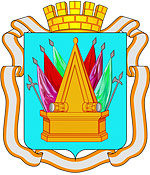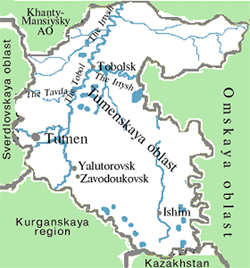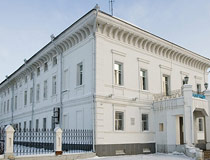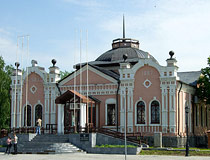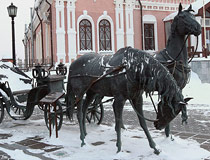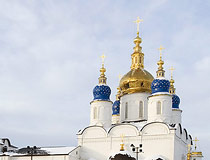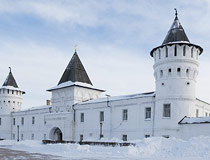Tobolsk - Overview
Tobolsk is a city in Russia located in Siberia, in the northern part of the Tyumen region, at the confluence of the Tobol and the Irtysh rivers. Tobolsk is the most important center of cultural tourism in Siberia and a large industrial center of the country in the field of gas chemistry.
The population of Tobolsk is about 98,100 (2022), the area - 222 sq. km.
The phone code - +7 3456, the postal codes - 626128, 626150-626159.
History of Tobolsk
According to the official version, Tobolsk was founded in the summer of 1587, about 17 km from the Tatar settlement of Siberia (also known as Kashlyk, Isker) (the former capital of the Siberian Khanate).
There is a legend that Tobolsk was founded near the site where Ermak’s soldiers landed during the Battle of Chuvash Cape after which the Siberian Khanate was annexed to Russia. The town’s first building was Trinity Church, and the cape was named Trinity Cape.
Until the 18th century, on maps, Tobolsk was sometimes referred to as “Siberia.” It became the second (after Tyumen) Russian town in Siberia.
Tobolsk became the center of Russian colonization of Siberia - the so-called “capital of Siberia”, which was formalized in the reforms of Peter the Great in 1708, when Tobolsk became the administrative center of the Siberian province, the largest province in the Russian Empire. It included the territory from Vyatka to the Russian America.
More Historical Facts…
This town was the starting point of the “Siberian exile.” The first exile was the Uglich Bell, used to raise the people to revolt after the mysterious death of Prince Dmitry, the youngest son of Ivan the Terrible. The bell was returned from Tobolsk only in the 19th century.
In the second decade of the 18th century, Swedish prisoners of war captured during the Russian-Swedish war were sent to Tobolsk. They took an active part in the construction of the town, made a significant contribution to its cultural life. In honor of the Swedes, one of the buildings of the Tobolsk Kremlin (Rentereya) has a second name - the “Swedish House.”
For the next generations of exiles, Tobolsk was a transit point to other places of exile in Siberia. Among these exiles were Fyodor Dostoevsky, Vladimir Korolenko, Alexander Solzhenitsyn, and other famous people.
The gradual decline of Tobolsk was associated with a range of factors. The most significant one was the relocation of the Siberian tract done to change the way of the development of Siberia, the shift of population and economic life in the south, in the forest-steppe zone.
In the 20th century, Tobolsk became known as the administrative center of the native province of Grigory Rasputin, the place of exile of the last Russian Emperor Nicholas II and his family, as well as one of the centers of a large uprising against the Bolsheviks - the peasant uprising in Siberia of 1921-1922.
During the Soviet regime, the Tobolsk petrochemical plant was built, one of the largest petrochemical plants in the Soviet Union.
Today, Tobolsk has a great potential for tourism development. A special federal program for the development of Tobolsk as a tourist center is adopted by authorities.
Pictures of Tobolsk
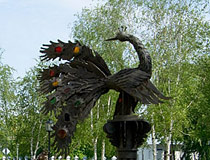
Firebird in the park in Tobolsk
Author: Dmitry Shchukin
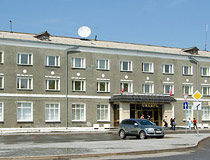
Siberia hotel in Tobolsk
Author: Dmitry Shchukin
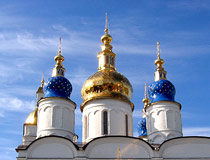
St. Sophia Cathedral in Tobolsk Kremlin
Author: Victor Pomortseff
Tobolsk - Features
Tobolsk, founded in 1587, was the center of Russian colonization of Siberia. Today, it is one of the most beautiful cities in Russia. Every stone breathes history here. Because of the peculiar topography, Tobolsk is divided into two parts - the upper and lower.
The climate is continental with severe long winters; short, relatively warm and humid summers; short springs and autumns. The average temperature in January is minus 17.1 degrees Celsius, in July - plus 18.7 degrees Celsius.
Tobolsk with its architecture and natural landscapes is the most important tourist center of Siberia. The combination of numerous architectural, museum, archaeological, religious, and memorial routes with rest on the Irtysh River, in suburban camps and recreation, sports and cultural centers - attracts children, youth and adults. In 2014, Tobolsk was visited by about 200 thousand tourists (only 807 of them were foreign tourists). The festival of historical reconstruction “Abalaksky field” becomes more and more popular.
There are more than 200 monuments of history and culture in Tobolsk, dozens of them are objects of cultural heritage of federal importance. Tobolsk is known as the third most important spiritual center of Russia, after Moscow and Saint Petersburg. Dmitri Ivanovich Mendeleev, a famous Russian chemist and inventor was born in Tobolsk, spent his childhood and youth in this town.
The city is the largest industrial center of the country in the field of processing of liquefied petroleum gases, as well as the production of polymers and monomers. Sibur Holding, one of the largest gas and petrochemical companies in Russia, is registered in the city.
Attractions of Tobolsk
Tobolsk State Historical and Architectural Museum-Reserve. This museum has about 300,000 exhibits on ethnography, archaeology, paleontology, as well as manuscripts and printed books, photo-collection, collection of belongings of the royal family (Krasnaya Square, 5).
Museum of Exploration of Siberia. The museum was opened in 2010. Thematic sections show the history of the exploration of Siberia and the role of Tobolsk as the center of the geographical, natural science and historical-ethnographic research (Oktyabrskaya Street, 5).
The Prison Castle, built near the Kremlin in 1838, served as a transit-convict prison. Such famous people as Dostoevsky, Chernyshevsky, Petrashevsky, Korolenko, Solzhenitsyn and others were prisoners who passed through it.
Other museums: The Governor’s Palace Museum (Krasnaya Square), Museum of Emperor Nicholas II (Mira Street, 10), Gubernskiy museum, a former Art Museum (Remezova Square, 10).
Tobolsk Kremlin. It is the only stone Kremlin in Siberia. Construction began in the late 17th century. The main object of the Kremlin is the majestic Cathedral of St. Sophia with a 75-meter bell tower. This cathedral is the oldest stone building in Siberia (1686).
Monasteries of Tobolsk. Abalakskiy Znamensky Monastery (the oldest monastery in Siberia) and Vvedensky Monastery are important from the point of view of religion, history and architecture.
Tobolsk State Drama Theater. The theater was founded in 1705 (4th micro-district, 66).
Tobolsk views
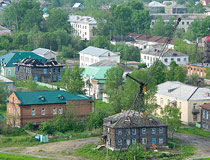
Tobolsk cityscape
Author: Dmitry Shchukin
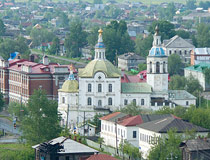
Old Tobolsk from above
Author: Dmitry Shchukin
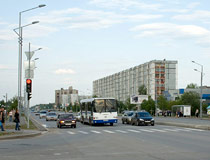
Crosswalk and apartment buildings in Tobolsk
Author: Dmitry Shchukin
Standing at the crossroads of trade routes, Tobolsk, for centuries, developed as a center for traditional crafts - carved bone and wood, jewelry. Tobolsk managed to keep production level of carving crafts - one of the most sought gift items for almost all tourists. Tobolsk has the only factory in Russia producing bone carving products, a tour on which is unforgettable for tourists.
How to get to Tobolsk
Tobolsk is located about 247 kilometers northeast of Tyumen.
By car. The highway R-404 from Tyumen to Tobolsk.
By bus. There are regular buses running from Tyumen to Tobolsk. In addition, you can go by bus from Ekaterinburg to Tobolsk (the buses going to Khanty-Mansiysk and Surgut).
By train. In the direction of Surgut, Nizhnevartovsk, Purpe, Korotchaevo, Noviy Urengoy (Tobolsk station).
By plane. The nearest airport is located in Tyumen (Roshchino Airport).



